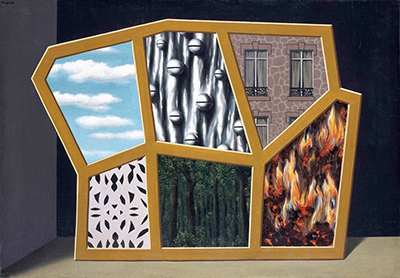Rene Magritte (1885-1967) was a Belgian artist who embraced the surrealist philosophy of portraying material objects in random and unlikely juxtapositions, such as we see in The Empty Mask (1928). In the painting, six irregular windows are bound together rather like stained-glass panels.
Through each window, going clockwise, we see a blue sky with white clouds, a pattern of nails in bark, classical windows set into the façade of a building, flames burning on wood, a dark forest and a black-and-white abstract pattern. The images are seemingly unrelated and do not tell any story. So, what is going on?
In 1924, French poet Andre Breton wrote the Surrealist Manifesto, in which he laid down how the parameters of classical art were too rigid and formal to speak for the modern world. He believed that art stemmed from words and images that came together in unlikely and random situations, such as we see in dreams. It is notable that Breton wrote his manifesto in the years following the publication of The Interpretation of Dreams (1900) by Sigmund Freud. Freud was a Viennese doctor who used the dream imagery of his patients to explore their neuroses and psychological disorders. By the early twentieth century, artists like Magritte, Salvador Dali and Max Ernst were using random imagery in creating their dream-like paintings.
One theme that runs through Magritte’s work is the dissociation of words from imagery. He painted La Trahison des Images (Ceci n’est pas une pipe) or The Betrayal of Images (This is not a pipe) in the same year as The Empty Mask. In the painting, we see a very shiny pipe suspended in space. It is not a pipe, of course, but the picture of a pipe untouched by human hand and never intended for tobacco. The artist is playing with our consciousness, as in The Empty Mask. He is asking us to question our tendency to place names upon everything, and our assumption that there is bound to be a connection between objects that are placed alongside one another. In the urban environment in which Magritte lived and worked, objects and incidents were as random as the events of a dream. In summary, The Empty Mask is an essay into consciousness, in which the artist is asking us to look once more and to think deeply about what we see.




